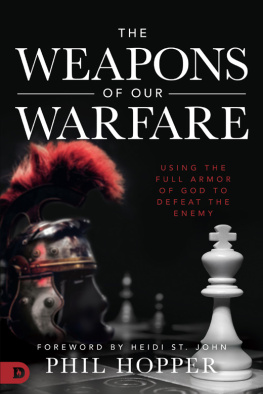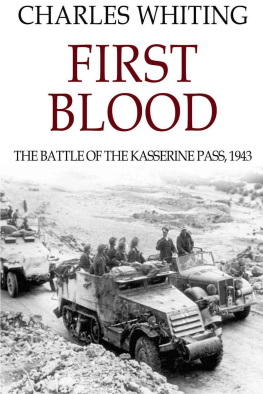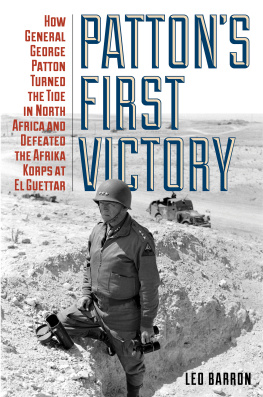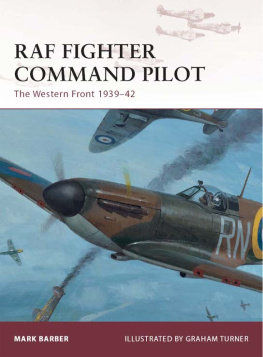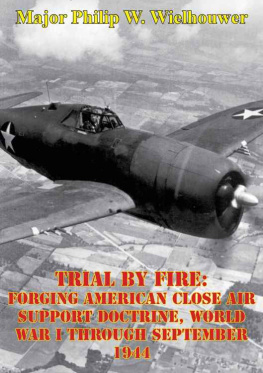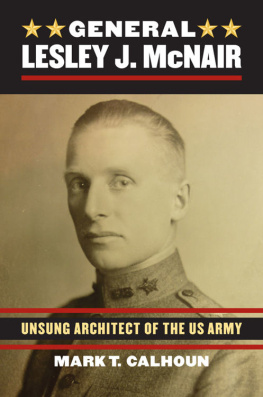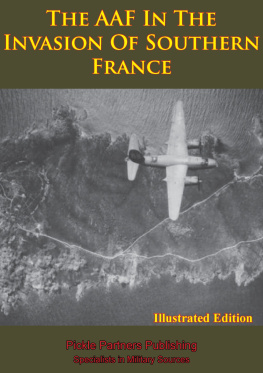This edition is published by PICKLE PARTNERS PUBLISHINGwww.picklepartnerspublishing.com
To join our mailing list for new titles or for issues with our books picklepublishing@gmail.com
Or on Facebook
Text originally published in 2003 under the same title.
Pickle Partners Publishing 2014, all rights reserved. No part of this publication may be reproduced, stored in a retrieval system or transmitted by any means, electrical, mechanical or otherwise without the written permission of the copyright holder.
Publishers Note
Although in most cases we have retained the Authors original spelling and grammar to authentically reproduce the work of the Author and the original intent of such material, some additional notes and clarifications have been added for the modern readers benefit.
We have also made every effort to include all maps and illustrations of the original edition the limitations of formatting do not allow of including larger maps, we will upload as many of these maps as possible.
DEFEAT AT KASSERINE: AMERICAN ARMOR DOCTRINE, TRAINING, AND BATTLE COMMAND IN NORTHWEST AFRICA, WORLD WAR II
By
Major Mark T. Calhoun
ABSTRACT
The 1st Armored Division was the first American armored unit to enter combat against German panzer divisions in World War II. A product of the contentious mechanization process between the First and Second World Wars, the division soon found itself to be outmatched by its German foe. Following a relatively easy victory against the Vichy French after the amphibious landings of Operation Torch, the division lost a series of battles to the Germans, culminating in a decisive defeat at Kasserine Pass. Doctrine (both institutional and equipment), training, and battle command all proved to be problematic for the division. The central question is: Did the 1st Armored Division lose the battle of Kasserine Pass because of deficiencies in American armor doctrine, training, or battle command? An analysis of the Tunisian campaign focusing on these three areas demonstrates that faulty training and inept battle command were partially responsible for the divisions defeat; however, the primary reason the 1st Armored Division lost the battle of Kasserine Pass was that it operated in accordance with flawed institutional doctrine and utilized inferior equipment.
ACKNOWLEDGMENTS
I would like to thank my family for their patience and understanding as I undertook this time-consuming project, and my committee for their guidance that helped me to focus my energies and organize my thoughts.
CHAPTER 1 INTRODUCTION
In June 1942, as the American 1st Armored Division made its final preparations to deploy to Northern Ireland and prepare for its entry into the war in Europe, it was not preparing to face Field Marshal Erwin Rommels Afrika Korps. The division was preparing to participate in an invasion of Europe, aimed at liberating France, striking into Germany, and bringing an early end to World War II. While the Combined Chiefs of Staff were planning this operation, two very powerful men had a different idea, for different reasons. President Franklin D. Roosevelt wanted to get American soldiers into combat against Germans as soon as possible, certainly in 1942, and no cross-channel invasion could be planned and executed that quickly. British Prime Minister Winston Churchill opposed making the initial thrust against Germany a cross-channel invasion, preferring to attack through Europes soft underbelly instead, a position he had also maintained in World War I. {1} In the midst of military planning for an invasion of Europe, these two men made the decision to invade North Africa in 1942, putting the cross-channel invasion off until at least 1943. {2} Thus began the planning for Operation Torch, an Allied amphibious invasion of Northwest Africa.
This sudden change of plans posed a number of challenges to the Allied forces, such as assembling a fleet large enough to transport invading forces 4,000 miles to North Africa, attempting to negotiate with Vichy French forces occupying Northwest Africa to forestall organized resistance to the landings, and shifting planning efforts to rapidly prepare for ground combat in Tunisia. The change also posed a major challenge to the American divisions chosen to invade Northwest Africa. The 1st Armored Division and the 1st and 34th Infantry Divisions were chosen to make the landings at Algiers and Oran. The 2nd Armored Division and the 3rd and 9th Infantry Divisions were selected to land to the west and secure French Morocco. These divisions were chosen not because they were the best prepared, but because they were the only units available. The Allied invasion force that landed in Northwest Africa during Operation Torch faced the Germans much earlier than planned, in a different theater than expected, with equipment that was inferior to that possessed by the Germans and with a severe disadvantage in experience. The fighting in Tunisia was some of the toughest the Americans faced in the European theater, and despite initial setbacks, they emerged a stronger, battle-hardened force, ready to face the challenges that awaited them in Sicily, Italy, Normandy and beyond.
The Allies participating in Operation Torch faced an enemy of dubious quality. The armistice established after the fall of France in June 1940 installed a new French government in Vichy, led by Marshal Henri Philippe Petain. German forces occupied the northern portion of France, while Vichy French forces remained in the southern portion of France and their North African territories. The Vichy French forces in Northwest Africa, consisting of about 135,000 men in 1942, were seriously constrained by the terms of the armistice. The Germans did not allow them to possess heavy artillery, antitank pieces, antiaircraft guns or motorized infantry, although they did leave French naval forces undisturbed. The Germans left the defense of Northwest Africa to the Vichy French forces, promising not to occupy the region with German troops as long as the French upheld the conditions of the armistice. {3}
Shortly after establishment of the armistice, an underground resistance movement began to develop in France, and the British government provided assistance to them as early as November 1940. In August 1941, Prime Minister Churchill recognized General Charles de Gaulle as leader of all free Frenchmen, and General de Gaulle began to form an army known as the Free French Forces with Allied assistance. This resulted in a divided France, with some citizens supporting Petains Vichy government, and others openly or secretly supporting de Gaulles Free French Forces. While some minor French North African territories renounced Vichy rule in favor of de Gaulle, the forces defending the key objectives of Operation Torch, French Morocco and Tunisia, remained firm supporters of Marshal Petain and the Vichy government. Their resolve was strengthened shortly after the armistice when British forces, trying to prevent German possession of the French Mediterranean fleet, attacked numerous French vessels resulting in nearly 2,000 French killed and wounded. {4}


